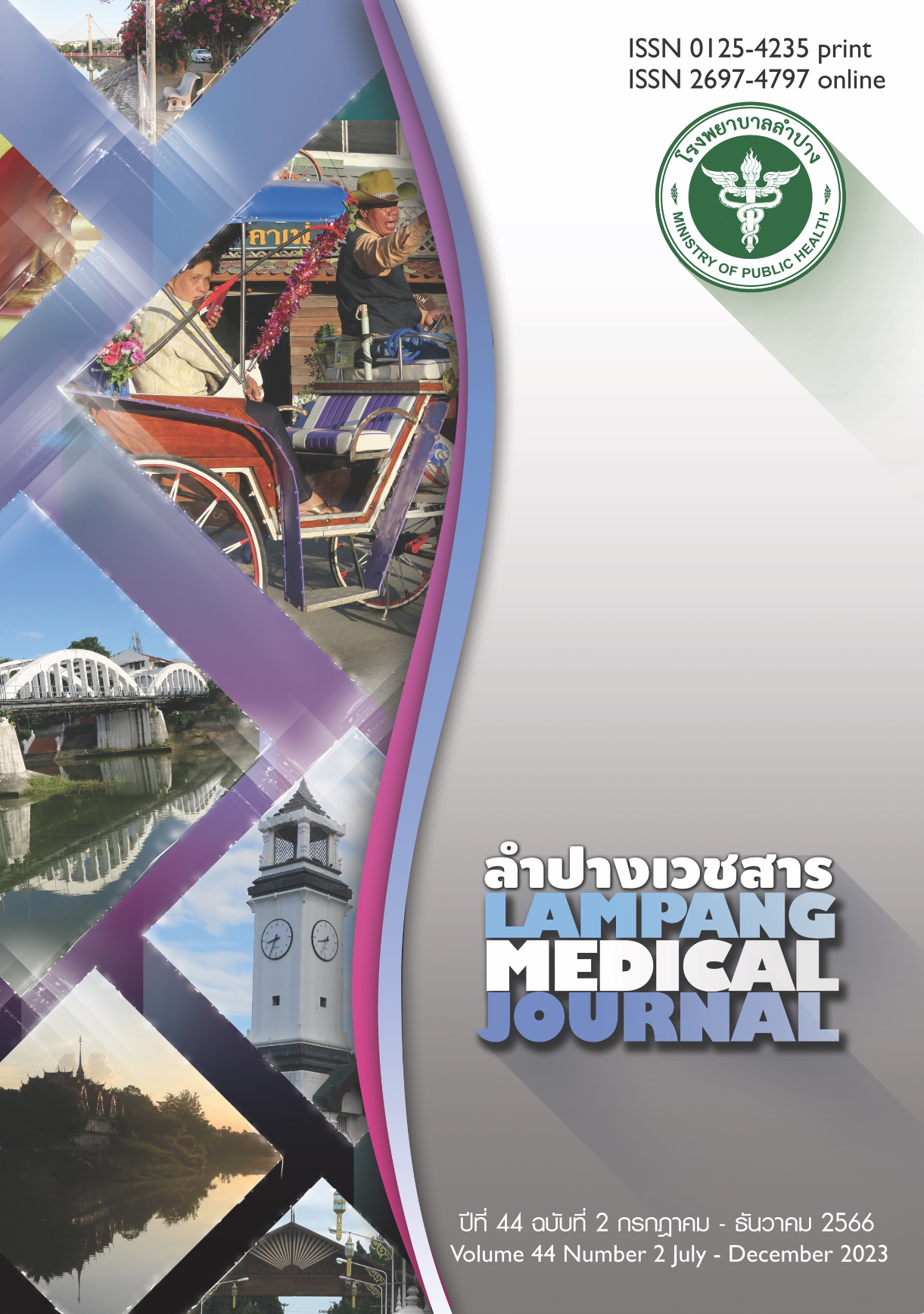Results of Hip Hemiarthroplasty for Femoral Neck Fracture using High-viscosity Bone Cement Injected with Invented Cement Gun
Main Article Content
Abstract
Background: The standard cementing technique for cemented hip arthroplasty requires an injection gun, with high-viscosity bone cement being preferred over low-viscosity cement. A novel gun, the Lampang Cement Gun for High-Viscosity Cement (LCG-HV), was invented based on a caulking gun to accomplish this task, serving as an alternative to the commercial cement gun
Objectives: To investigate the efficacy of the LCG-HV and analyze the unit cost, as well as determine the clinical results of cemented bipolar hip hemiarthroplasty using the LCG-HV in terms of quality of cementation and functional outcome.
Material and methods: The first part of the research involved an experimental study using the LCG-HV to inject Palacos R high-viscosity cement. The injection speed and maximum trigger force were measured, and the unit cost per single usage was calculated. The second part of the research was a retrospective cohort study among 52 patients with femoral neck fractures who underwent cemented bipolar hip hemiarthroplasty at Lampang Hospital from January 2019 to April 2023. This procedure used high-viscosity cement and the LCG-HV. Cementation quality was assessed through radiographic evaluation using the Barrack grading system, and the Harris Hip Score (HHS)was assessed at 6 to 12 months postoperatively.
Results: The mean injection speed of the LCG-HV was 4.1±0.4 g/sec (range 3.5–4.5), and the maximum trigger force was 135±10 kg-force (range 124–145). The unit cost of the LCG-HV was 250 Baht for one-time usage (comprising a direct cost of 225 Baht and an indirect cost of 25 Baht). The mean age of the patients was 81.4±7.9 years (range 63–97), with 47 cases being female (90.4%). The types of femoral prostheses used were the Avenir stem in 38 cases (73.1%), the CPT stem in 11 cases (21.1%), and the Excia stem in 3 cases (5.8%). The cementation quality was mostly
categorized as Barrack grade B (53.8%) and grade A (40.4%). Postoperatively, the mean HHS was 76.8±6.9, with 23 cases (44.2%) classified as having excellent or good levels.
Conclusion: LCG-HV features an injection speed suitable for high-viscosity bone cement and a maximum trigger force at the standard level. Its unit cost is lower than that of a commercial gun. Clinical utilization in bipolar hip hemiarthroplasty has provided satisfactory postoperative results and has been able to achieve optimal quality of cementation.
Article Details

This work is licensed under a Creative Commons Attribution-NonCommercial-NoDerivatives 4.0 International License.
บทความที่ส่งมาลงพิมพ์ต้องไม่เคยพิมพ์หรือกำลังได้รับการพิจารณาตีพิมพ์ในวารสารอื่น เนื้อหาในบทความต้องเป็นผลงานของผู้นิพนธ์เอง ไม่ได้ลอกเลียนหรือตัดทอนจากบทความอื่น โดยไม่ได้รับอนุญาตหรือไม่ได้อ้างอิงอย่างเหมาะสม การแก้ไขหรือให้ข้อมูลเพิ่มเติมแก่กองบรรณาธิการ จะต้องเสร็จสิ้นเป็นที่เรียบร้อยก่อนจะได้รับพิจารณาตีพิมพ์ และบทความที่ตีพิมพ์แล้วเป็นสมบัติ ของลำปางเวชสาร
References
Rojanasthien S, Luevitoonvechkij S. Epidemiology of hip fracture in Chiang Mai. J Med Assoc Thai 2005; 88(Sppl 5):S105–9.
Khan RJ, MacDowell A, Crossman P, Datta A, Jallali N, Arch BN, Keene GS. Cemented or uncemented hemiarthroplasty for displaced intracapsular femoral neck fractures. Int Orthop 2002;26:229–32.
Simpson P, Breusch SJ. Optimal cementing technique- the evidence: cement gun performance matters. In: Breusch SJ, Malchau H, editors. The well-cemented total hip arthroplasty: theory and practice. Heidelberg:
Springer; 2005. p.155–9.
Pongkunakorn A, Pengkong N, Maneeratroj W. Comparison of caulking gun and standard cement gun using for femoral cementation. J Med Assoc Thai 2008; 91(1):62–7.
Pongkunakorn A, Thisayukta P, Palawong P. Invention technique and clinical results of Lampang cement injection gun used in hip hemiarthroplasty. J Med Assoc Thai 2009; 92 (Suppl 6): S232–8.
Havelin LI, Espehaug B, Vollset SE, Engesaeter LB. The effect of the type of cement on early revision of Charnley total hip prostheses. A review of eight thousand five hundred and seventy-nine primary arthroplasties from the Norwegian Arthroplasty Register. J Bone Joint Surg Am 1995; 77:154–50.
Malchau H, Herberts P, Soderman P, Oden A. Prognosis of total hip replacement. Update and validation of results from the Swedish National Hip Arthroplasty Registry 1979–1998. In the 67th AAOS annual meeting; 2000 March 15–19; Orlando, USA; 2000.
Heisel C, Schelling K, Thomsen M, Schneider U, Breusch SJ. Cement delivery depends on cement gun performance and cement viscosity. Z Orthop 2003; 141:99–104.
Barrack RL, Mulroy RD, Harris WH. Improved cementing technique and femoral component loosening in young patients with hip arthroplasty : a 12-year radiographic review. J Bone Joint Surg Br 1992; 74:385–9.
Harris W. Traumatic arthritis of the hip after dislocation and acetabular fractures: treatment by mold arthroplasty. J Bone Joint Surg Am 1969;51:737–55.
Udomluck P. Efficacy of injection gun for medium-viscosity bone cement: comparison between invented gun and standard commercial gun. Lampang Med J 2020;41(1): 18–29.
McGoldrick NP, Fischman D, Nicol GM, Kreviazuk C, Grammatopoulos G, Beaulé PE. Cementing a collarless polished tapered femoral stem through the anterior approach: evaluation of cement mantle quality and component
alignment. Bone Joint J. 2021;103-B (7 Suppl B):46–52.
Wang F, Zhang H, Zhang Z, Ma C, Feng X. Comparison of bipolar hemiarthroplasty and total hip arthroplasty for displaced femoral neck fractures in the healthy elderly: a meta-analysis. BMC Musculoskelet Disord. 2015;16:229.


